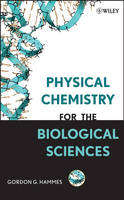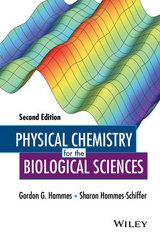
Physical Chemistry for the Biological Sciences
Wiley-Blackwell (Verlag)
978-0-470-12202-0 (ISBN)
- Titel erscheint in neuer Auflage
- Artikel merken
Gain a practical, working knowledge of the physical chemistry essential for the biological sciences Physical Chemistry for the Biological Sciences is an excellent resource for biochemistry and biology/health science professionals and students who need a basic understanding of thermodynamics, kinetics, hydrodynamics of macromolecules, and spectroscopy in order to explore molecular structure and chemical reactions. Approachable, yet thorough, the book presents physical chemistry in conceptual terms with a minimum of mathematics. Providing the basic knowledge and tools that every biologist should have to understand the quantitative interpretation of biological phenomena, it covers: Fundamentals of thermodynamics and chemical kinetics Fundamentals of spectroscopy and structure determination Ligand binding to macromolecules, hydrodynamics, and mass spectrometry All techniques and concepts are clearly illustrated with relevant applications and examples from the biological sciences. Problems at the end of each chapter reinforce the principles.
This is a succinct reference for practitioners, including bioorganic chemists, medicinal chemists, biochemists, pharmaceutical chemists, biologists, and professionals in fields such as pharmaceuticals, agriculture, and biotechnology. It's also an excellent textbook for graduate and upper-level undergraduate students in biochemistry, biology, and related fields.
Gordon G. Hammes, PhD, is University Distinguished Service Professor of Biochemistry at Duke University Medical Center in Durham, North Carolina. He is author of Thermodynamics and Kinetics for the Biological Sciences and Spectroscopy for the Biological Sciences (both from Wiley) and more than 225 research articles.
PREFACE. THERMODYNAMICS. 1. Heat, Work, and Energy. 1.1 Introduction. 1.2 Temperature. 1.3 Heat. 1.4 Work. 1.5 Definition of Energy. 1.6 Enthalpy. 1.7 Standard States. 1.8 Calorimetry. 1.9 Reaction Enthalpies. 1.10 Temperature Dependence of the Reaction Enthalpy. References. Problems. 2. Entropy and Free Energy. 2.1 Introduction. 2.2 Statement of the Second Law. 2.3 Calculation of the Entropy. 2.4 Third Law of Thermodynamics. 2.5 Molecular Interpretation of Entropy. 2.6 Free Energy. 2.7 Chemical Equilibria. 2.8 Pressure and Temperature Dependence of the Free Energy. 2.9 Phase Changes. 2.10 Additions to the Free Energy. Problems. 3. Applications of Thermodynamics to Biological Systems. 3.1 Biochemical Reactions. 3.2 Metabolic Cycles. 3.3 Direct Synthesis of ATP. 3.4 Establishment of Membrane Ion Gradients by Chemical Reactions. 3.5 Protein Structure. 3.6 Protein Folding. 3.7 Nucleic Acid Structures. 3.8 DNA Melting. 3.9 RNA. References. Problems. CHEMICAL KINETICS. 4. Principles of Chemical Kinetics. 4.1 Introduction. 4.2 Reaction Rates. 4.3 Determination of Rate Laws. 4.4 Radioactive Decay. 4.5 Reaction Mechanisms. 4.6 Temperature Dependence of Rate Constants. 4.7 Relationship between Thermodynamics and Kinetics. 4.8 Reaction Rates Near Equilibrium. References. Problems. 5. Applications of Kinetics to Biological Systems. 5.1 Introduction. 5.2 Enzyme Catalysis: The Michaelis-Menten Mechanism. 5.3 a-Chymotrypsin. 5.4 Protein Tyrosine Phosphatase. 5.5 Ribozymes. 5.6 DNA Melting and Renaturation. References. Problems. SPECTROSCOPY. 6. Fundamentals of Spectroscopy. 6.1 Introduction. 6.2 Quantum Mechanics. 6.3 Particle in a Box. 6.4 Properties of Waves. References. Problems. 7. X-ray Crystallography. 7.1 Introduction. 7.2 Scattering of X rays by a Crystal. 7.3 Structure Determination. 7.4 Neutron Diffraction. 7.5 Nucleic Acid Structure. 7.6 Protein Structure. 7.7 Enzyme Catalysis. References. Problems. 8. Electronic Spectra. 8.1 Introduction. 8.2 Absorption Spectra. 8.3 Ultraviolet Spectra of Proteins. 8.4 Nucleic Acid Spectra. 8.5 Prosthetic Groups. 8.6 Difference Spectroscopy. 8.7 X-ray Absorption Spectroscopy. 8.8 Fluorescence and Phosphorescence. 8.9 RecBCD: Helicase Activity Monitored by Fluorescence. 8.10 Fluorescence Energy Transfer: A Molecular Ruler. 8.11 Application of Energy Transfer to Biological Systems. 8.12 Dihydrofolate Reductase. References. Problems. 9. Circular Dichroism, Optical Rotary Dispersion, and Fluorescence Polarization. 9.1 Introduction. 9.2 Optical Rotary Dispersion. 9.3 Circular Dichroism. 9.4 Optical Rotary Dispersion and Circular Dichroism of Proteins. 9.5 Optical Rotation and Circular Dichroism of Nucleic Acids. 9.6 Small Molecule Binding to DNA. 9.7 Protein Folding. 9.8 Interaction of DNA with Zinc Finger Proteins. 9.9 Fluorescence Polarization. 9.10 Integration of HIV Genome into Host Genome. 9.11 a-ketoglutarate Dehydrogenase. References. Problems. 10. Vibrations in Macromolecules. 10.1 Introduction. 10.2 Infrared Spectroscopy. 10.3 Raman Spectroscopy. 10.4 Structure Determination with Vibrational Spectroscopy. 10.5 Resonance Raman Spectroscopy. 10.6 Structure of Enzyme-Substrate Complexes. References. Problems. 11. Principles of Nuclear Magnetic Resonance and Electron Spin Resonance. 11.1 Introduction. 11.2 NMR Spectrometers. 11.3 Chemical Shifts. 11.4 Spin-Spin Splitting. 11.5 Relaxation Times. 11.6 Multidimensional NMR. 11.7 Magnetic Resonance Imaging. 11.8 Electron Spin Resonance. References. Problems. 12. Applications of Magnetic Resonance to Biology. 12.1 Introduction. 12.2 Regulation of DNA Transcription. 12.3 Protein-DNA Interactions. 12.4 Dynamics of Protein Folding. 12.5 RNA Folding. 12.6 Lactose Permease. 12.7 Conclusion. References. SPECIAL TOPICS. 13. Ligand Binding to Macromolecules. 13.1 Introduction. 13.2 Binding of Small Molecules to Multiple Identical Binding Sites. 13.3 Macroscopic and Microscopic Equilibrium Constants. 13.4 Statistical Effects in Ligand Binding to Macromolecules. 13.5 Experimental Determination of Ligand Binding Isotherms. 13.6 Binding of Cro Repressor Protein to DNA. 13.7 Cooperativity in Ligand Binding. 13.8 Models for Cooperativity. 13.9 Kinetic Studies of Cooperative Binding. 13.10 Allosterism. References. Problems. 14. Hydrodynamics of Macromolecules. 14.1 Introduction. 14.2 Frictional Coefficient. 14.3 Diffusion. 14.4 Centrifugation. 14.5 Velocity Sedimentation. 14.6 Equilibrium Centrifugation. 14.7 Preparative Centrifugation. 14.8 Density Centrifugation. 14.9 Viscosity. 14.10 Electrophoresis. 14.11 Peptide-Induced Conformational Change of a Major Histocompatibility Complex Protein. 14.12 Ultracentrifuge Analysis of Protein-DNA Interactions. References. Problems. 15. Mass Spectrometry. 15.1 Introduction. 15.2 Mass Analysis. 15.3 Tandem Mass Spectrometry (MS/MS). 15.4 Ion Detectors. 15.5 Ionization of the Sample. 15.6 Sample Preparation/Analysis. 15.7 Proteins and Peptides. 15.8 Protein Folding. 15.9 Other Biomolecules. References. Problems. APPENDICES. Appendix 1. Useful Constants and Conversion Factors. Appendix 2. Structures of the Common Amino Acids at Neutral pH. Appendix 3. Common Nucleic Acid Components. Appendix 4. Standard Free Energies and Enthalpies of Formation at 298 K, 1 atm, pH 7, and 0.25M Ionic Strength. Appendix 5. Standard Free Energy and Enthalpy Changes for Biochemical Reactions at 298 K, 1 atm, pH 7.0, pMg 3.0, and 0.25M Ionic Strength. Index.
| Erscheint lt. Verlag | 26.4.2007 |
|---|---|
| Reihe/Serie | Methods of Biochemical Analysis |
| Zusatzinfo | Illustrations |
| Verlagsort | Hoboken |
| Sprache | englisch |
| Maße | 164 x 236 mm |
| Gewicht | 656 g |
| Themenwelt | Naturwissenschaften ► Chemie ► Physikalische Chemie |
| ISBN-10 | 0-470-12202-1 / 0470122021 |
| ISBN-13 | 978-0-470-12202-0 / 9780470122020 |
| Zustand | Neuware |
| Haben Sie eine Frage zum Produkt? |
aus dem Bereich



